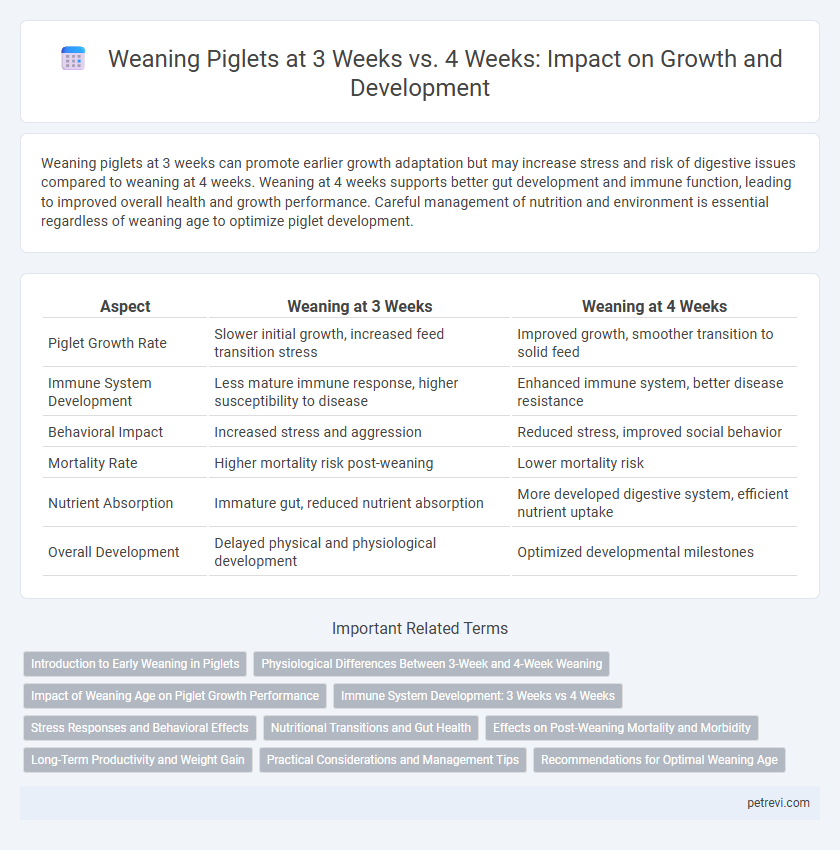Weaning piglets at 3 weeks can promote earlier growth adaptation but may increase stress and risk of digestive issues compared to weaning at 4 weeks. Weaning at 4 weeks supports better gut development and immune function, leading to improved overall health and growth performance. Careful management of nutrition and environment is essential regardless of weaning age to optimize piglet development.
Table of Comparison
| Aspect | Weaning at 3 Weeks | Weaning at 4 Weeks |
|---|---|---|
| Piglet Growth Rate | Slower initial growth, increased feed transition stress | Improved growth, smoother transition to solid feed |
| Immune System Development | Less mature immune response, higher susceptibility to disease | Enhanced immune system, better disease resistance |
| Behavioral Impact | Increased stress and aggression | Reduced stress, improved social behavior |
| Mortality Rate | Higher mortality risk post-weaning | Lower mortality risk |
| Nutrient Absorption | Immature gut, reduced nutrient absorption | More developed digestive system, efficient nutrient uptake |
| Overall Development | Delayed physical and physiological development | Optimized developmental milestones |
Introduction to Early Weaning in Piglets
Weaning piglets at 3 weeks accelerates gastrointestinal maturation and stimulates early feed intake, enhancing post-weaning growth performance compared to traditional 4-week weaning. Early weaning promotes stronger immune system development by reducing exposure to sow pathogens and encouraging gut microbiota diversification. However, managing stress and providing specialized nutrition are critical to offset potential growth setbacks during the transition from sow's milk to solid feed.
Physiological Differences Between 3-Week and 4-Week Weaning
Weaning piglets at 3 weeks often results in heightened stress responses and reduced gut enzyme activity compared to 4-week weaning, which supports better intestinal development and nutrient absorption. At 4 weeks, piglets exhibit more mature immune function and improved feed efficiency, contributing to enhanced growth performance. Early weaning interrupts the establishment of beneficial gut microbiota, leading to increased susceptibility to gastrointestinal disorders and slower physiological adaptation.
Impact of Weaning Age on Piglet Growth Performance
Weaning piglets at 4 weeks typically results in improved growth performance compared to weaning at 3 weeks, as the longer suckling period enhances nutrient absorption and immune system development. Studies show that piglets weaned at 4 weeks exhibit higher average daily gain (ADG) and better feed conversion ratios (FCR) in the post-weaning phase. Early weaning at 3 weeks often leads to increased stress and gastrointestinal disturbances, negatively affecting growth uniformity and overall health status.
Immune System Development: 3 Weeks vs 4 Weeks
Weaning piglets at 4 weeks allows for more robust immune system development due to extended exposure to sow's antibodies and gradual adaptation to solid feed. At 3 weeks, piglets often experience increased stress and reduced passive immunity transfer, resulting in a higher susceptibility to infections and slower immune maturation. Studies show that extended lactation promotes enhanced production of immunoglobulins and stronger intestinal immune responses, critical for early-life disease resistance.
Stress Responses and Behavioral Effects
Weaning piglets at 3 weeks often leads to heightened stress responses, including increased cortisol levels and more pronounced vocalizations compared to those weaned at 4 weeks. Behavioral effects observed in early-weaned piglets include reduced social interactions and increased aggression, which can impair growth and immune function. Extending the weaning age to 4 weeks supports better psychological development and smoother transition to solid feed, resulting in improved overall welfare and productivity.
Nutritional Transitions and Gut Health
Weaning piglets at 3 weeks accelerates the transition from sow milk to solid feed, which can challenge gut development and increase the risk of digestive disorders due to immature enzyme systems. Extending weaning to 4 weeks allows for a more gradual nutritional transition, promoting better gut mucosa maturation and more stable microflora, enhancing nutrient absorption and immune function. Optimizing weaning age supports improved growth rates, reduced post-weaning diarrhea, and overall piglet health by balancing early dietary stress with gut development needs.
Effects on Post-Weaning Mortality and Morbidity
Weaning piglets at 3 weeks often leads to higher post-weaning mortality and morbidity due to immature gut development and weaker immune response, increasing vulnerability to enteric diseases and stress-induced health issues. In contrast, weaning at 4 weeks allows for more robust digestive enzyme activity and improved immune system maturity, which typically reduces the incidence of diarrhea and respiratory infections post-weaning. Optimizing weaning age to 4 weeks can enhance piglet survival rates and growth performance by minimizing physiological stress and disease susceptibility during this critical developmental phase.
Long-Term Productivity and Weight Gain
Weaning piglets at 4 weeks promotes improved long-term weight gain by allowing extended access to sow milk, which enhances gut development and nutrient absorption. Studies indicate piglets weaned at 3 weeks may experience increased stress and slower growth rates, negatively impacting overall productivity in later stages. Extended weaning periods support stronger immune function and more consistent daily weight gain, contributing to higher market weights and better feed efficiency.
Practical Considerations and Management Tips
Weaning piglets at 3 weeks requires careful management of nutrition and environment to minimize stress and promote growth, including gradual diet transitions and maintaining warm, clean housing. Waiting until 4 weeks allows for more developed immune function and digestive systems, reducing post-weaning diarrhea and improving feed efficiency. Practical considerations involve balancing labor costs and piglet health risks, with tailored vaccination schedules and monitoring for early signs of illness critical for both weaning ages.
Recommendations for Optimal Weaning Age
Weaning piglets at 4 weeks promotes better digestive system development and reduces stress-related health issues compared to weaning at 3 weeks, leading to improved growth rates and feed efficiency. Research indicates that piglets weaned at 4 weeks exhibit stronger immune responses and higher survival rates, minimizing post-weaning diarrhea and associated economic losses. Optimal weaning age recommendations emphasize balancing early growth benefits with minimizing physiological stress, suggesting 4 weeks as the preferred age for transitioning piglets from sow milk to solid feed.
Weaning at 3 weeks vs Weaning at 4 weeks for Piglet development Infographic

 petrevi.com
petrevi.com